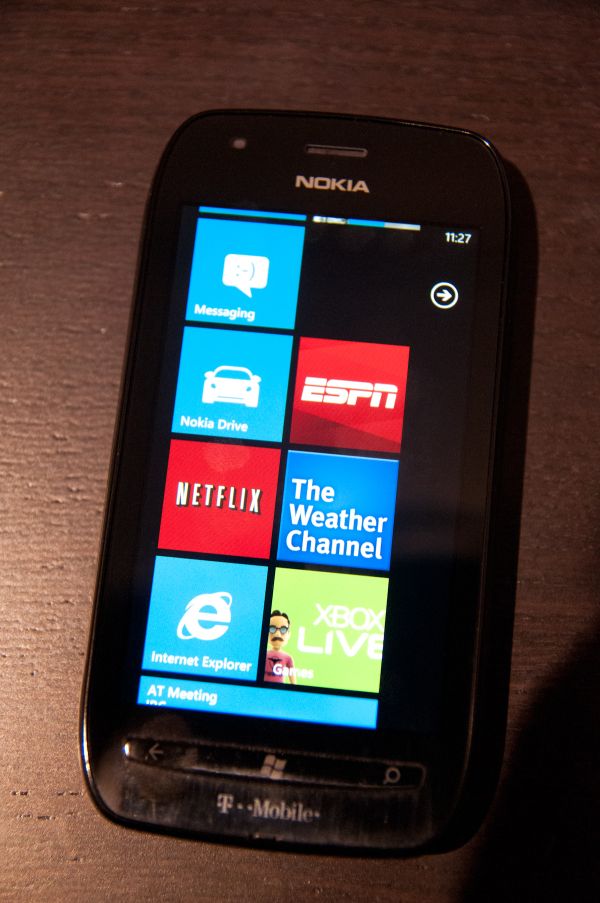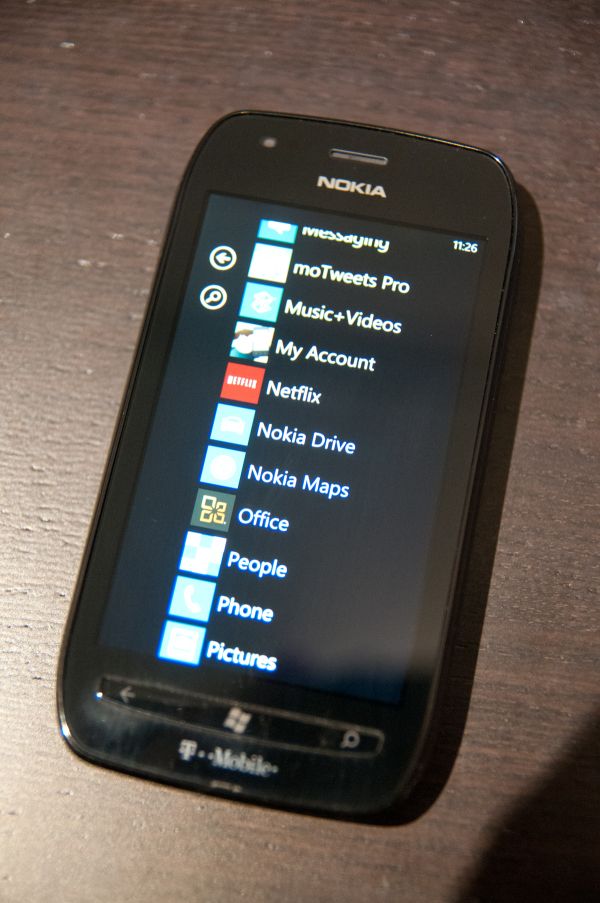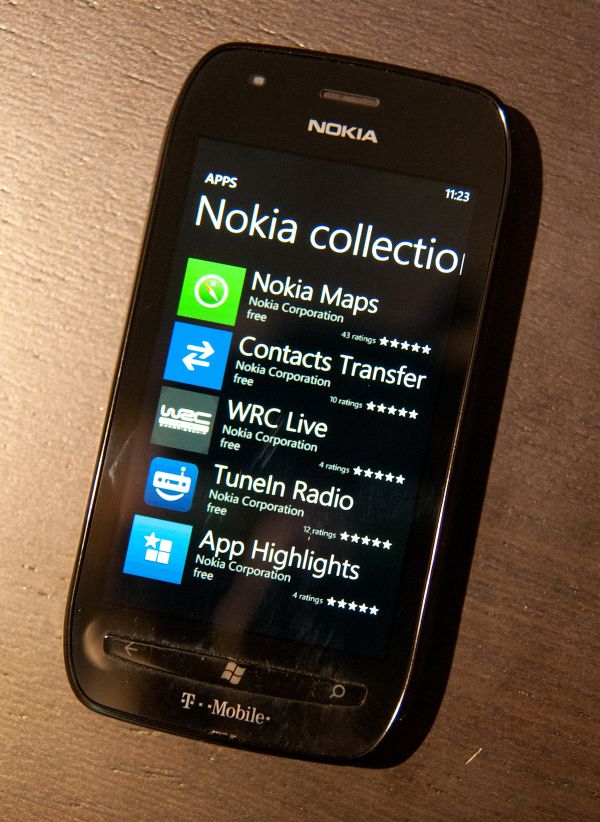Nokia Lumia 710 Review - T-Mobile's Nokia WP7
by Brian Klug on January 5, 2012 12:01 AM EST- Posted in
- Smartphones
- Nokia
- Mobile
- WP7
- Lumia 710
Lumia 710 - Software Preload
The Lumia 710 we were sampled is headed for T-Mobile, and as a result comes with some software preloads. Among those are T-Mobile TV, T-Mobile My Account, TeleNav GPS Nav, Nokia Drive, and an ESPN app.
Thankfully unlike Android 2.x, you aren’t stuck with these preloads for the life of the device or until you root and remove, as WP7 allows for easy uninstallation of any of these preloaded applications.
Obviously T-Mobile My Account is somewhat useful for managing your account information and checking use, but besides the preloaded Nokia applications, I find almost all preloads annoying. Obviously on a device with just 8 GB of NAND keeping this to a minimum is important.
Nokia’s Apps
The Lumia 710 doesn’t come with all of Nokia’s software portfolio installed out of the box, just Nokia Drive. It’s somewhat puzzling that T-Mobile decided to also include TeleNav GPS Nav since Nokia Drive is free on the Lumia series and provides the same turn-by-turn navigation features, but for whatever reason that’s the way things are.
I talked about the Nokia application portfolio in the Lumia 800 review at some length if you’re interested in more details. Suffice it to say that Nokia Drive does a nice job getting the job done, and has gotten more and more speedy with each update since I first saw it. On first launch, Nokia Drive fetches maps and voices over WiFi, so you’ll have to launch this before setting out for some driving.
The interesting thing about the 710 is that the Marketplace application now has a “Nokia Collection” pivot which is home to all the Nokia applications. Maps, Contacts Transfer, and a few others are all present here. Nokia Music and Drive aren’t included here, though Drive is still updated through the marketplace like on the 800. I wager depending on what carrier you’re getting the 710 on, the combination of preload and Nokia preinstalled applications will change.
Obviously the Nokia 710 comes with WP7.5 Mango, specifically build 7740 (7.19.7740.16) on the device we tested.














48 Comments
View All Comments
PubFiction - Sunday, January 8, 2012 - link
Nokia may be working on their new core competency. Lots of companies do this same thing and roll just fine. Vizio, Apple to name a few. Do the design then outsource everything else.PubFiction - Sunday, January 8, 2012 - link
I should also add that nokia tried to make symbian work and they failed. They have gone from one of the worlds most recognised phone makers to almost nothing. I mean you can go into any phone provider in the US and I am not sure if you would see any nokia phones.So ya the whole making a competing OS in Europe thing just did not work out for them.
a5cent - Monday, January 9, 2012 - link
Symbian was not doomed due to it being developed in Europe. One of the main difficulties was that the developer was essentially a hardware company. Hardware and software development are very different, and requires a different company culture and different management. American hardware companies that attempt software almost always fail as well. Apple is probably the only exception... Apple is probably the worlds only systems company.Spivonious - Thursday, January 5, 2012 - link
Windows has poor multithreading? What are you talking about? Windows has supported multi-tasking (which is what I assume you mean, since only recently (last 5-10 years) have we gotten CPUs capable of operating more than one thread at a time) since Windows 1.0.WP7 has supported multi-tasking since launch. The API was opened up to 3rd party developers with the 7.5/Mango update.
As an owner of a WP7 phone and a user of iOS, Android, and RIM, I can veritably say that it is the best, most well-designed mobile OS out right now.
Apple doesn't make iPhones either. You may as well get over losing your factory job and realize that in the world economy, you make the product whereever you can get the best deal.
melgross - Thursday, January 5, 2012 - link
I haven't read past the first page yet, but the weights caught my eye. I don't know if the weight in grams is correct, or the weight in ounces, but there is a discrepancy.Assuming that grams is correct, the weight, in ounces, of the 800 should be 4.41, and the weight of the 710 is pretty close, but is then a bit more at 4.43.
jsv35 - Thursday, January 5, 2012 - link
Thank you for taking time and doing reviews on Windows Phone, it's always nice to see. I have an android device myself, but have always kind of liked the look of WP7zinfamous - Thursday, January 5, 2012 - link
Agreed.I don't follow the GPU and general hardware reviews as much as I used to, but the scope of those is what brought me to AT in the first place. I now see that same level of detail now with the phone reviews, and I would never purchase a phone without getting the skinny from AT first.
They have become the best on the web. Even the camera reviews are (were?) just as detailed at one time.
Kudos.
melgross - Thursday, January 5, 2012 - link
What I found interesting is that while neither the 800 or the 710 performed well, though as expected, the LCD screen of the 710 is MUCH brighter than the AMOLED screen of the 800, both phones performed much better than the extremely dismal performance of the N8, a phone which, for some unexplainable reason, is thought by some to be a super phone. To me, it seems a dud.kyuu - Thursday, January 5, 2012 - link
While integration/overlap with Windows on the PC and with the Xbox is certainly an interesting proposition and would be a boon, that's not what I (and probably a lot of others) are waiting for in order to jump ship to the Windows Phone platform. I love the WP UI, I love the *idea* (though not execution so far) of the controlled hardware platforms as opposed to Android's uncontrolled, fragmented mess and the singular, completely restricted iPhone platform.What I'm waiting for to jump are:
1) A more modern hardware platform. I understand all the arguments about why WP doesn't *need* a dual-core yadda yadda, but I have no interest in side-grading from my iPhone 4 to a hardware platform with pretty much exactly the same capabilities. I want an *upgrade* for my investment. And besides, when the hardware capability is there, the software that takes advantage of it will follow suit, and I've seen plenty of reports that 3rd-party Silverlight-based software does indeed suffer slowdown. I need at least a dual-core with a reasonably capable GPU.
2) I need an SD-card slot or some other way to increase the available storage. High-end devices with 8, 16, or even 32GB of NAND with no upgradability is simply not sufficient.
3) A quality screen with a pixel density that's at least competitive with what my iPhone 4 has. I don't want to downgrade to a screen that's looks worse.
I'm hoping by the end of this year with WP8 out, attractive hardware will be out so I can jump to the Windows Phone platform and never look back.
a5cent - Friday, January 6, 2012 - link
Excellent! I agree, and wonder how many other people feel similarly. I suspect you almost have to be a software developer to really appreciate the benefits of the controlled hardware platform. Microsoft's ability to guarantee that every WP device owner will get every update is one such benefit. However, other benefits that are more easily appreciated by end users have yet to materialize.I don't know about expandable storage, but we know the other issues will be resolved with WP8.
I'm also holding on to my current phone. I will also go for WP8 if:
a) we get very tight integration between W8 and WP8
b) we get some AAA applications and games directly from MS which make use of WP8 hardware